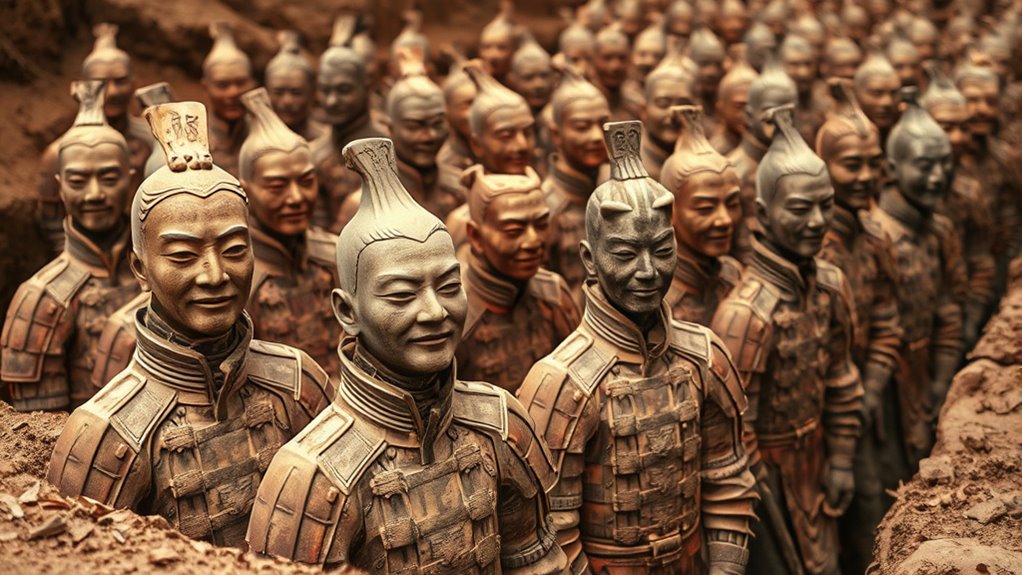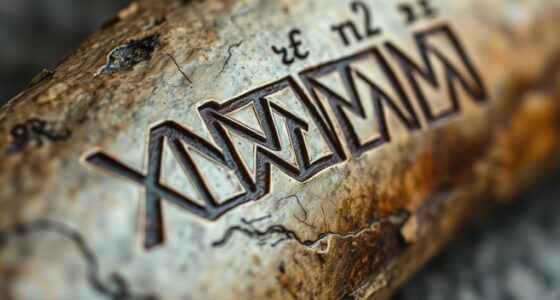Recent discoveries show the Terracotta Army stretches much farther than previously thought, revealing a larger mausoleum complex for China’s first Emperor. Advanced archaeological techniques like ground-penetrating radar have uncovered new pits filled with warriors, horses, and chariots. Each figure is uniquely crafted, indicating the scale and importance of this funerary site. If you continue exploring, you’ll uncover even more fascinating details about the grandeur and significance of this incredible ancient Chinese treasure.
Key Takeaways
- Recent excavations reveal additional pits filled with warriors, horses, and chariots, indicating a larger mausoleum complex than previously known.
- Ground-penetrating radar and 3D imaging techniques help locate and map new sections without disturbing the site.
- New finds show diverse and personalized figures, providing deeper insights into ancient Chinese funeral rituals and societal hierarchy.
- Ongoing discoveries suggest the extensive resources and craftsmanship dedicated to Emperor Qin Shi Huang’s burial customs.
- These discoveries enhance understanding of the mausoleum’s scale, complexity, and the cultural significance of funerary practices.

Have you ever wondered how ancient China demonstrated its imperial power? The answer lies in the remarkable discovery of the Terracotta Army, a vast army of life-sized clay soldiers buried with China’s first Emperor, Qin Shi Huang. These figures weren’t just art; they served a pivotal purpose in funeral rituals, ensuring the emperor’s protection and status in the afterlife. When you think about it, the grandeur of these funerary practices reveals how seriously ancient Chinese rulers took their legacy, using elaborate burial customs to project authority beyond death.
Uncovering the secrets of the Terracotta Army required sophisticated archaeological techniques. When the site was first excavated in the 1970s, experts used careful excavation methods to avoid damaging these fragile sculptures. Since then, advancements like ground-penetrating radar and 3D imaging have played essential roles in locating and mapping new sections of the mausoleum without disturbing the archaeological context. These techniques help reveal the full extent of the burial complex, which extends far beyond the initial discovery site. The ongoing exploration continues to uncover new pits filled with warriors, horses, chariots, and weapons, offering a deeper understanding of the scale and craftsmanship involved.
The significance of these new finds extends beyond mere numbers. They provide insight into the funerary rituals of the time, illustrating how the emperor’s court prepared for the afterlife. Each figure was meticulously crafted, with distinct facial features and clothing, representing different ranks and roles within the army. This attention to detail underscores the importance of honoring the deceased with a personalized retinue, ensuring their safety and status in the next world. The discovery of new burial pits also suggests that the mausoleum complex was even larger than previously thought, hinting at the immense resources dedicated to Emperor Qin’s funerary customs. Additionally, these discoveries highlight the importance of detailed craftsmanship in ancient Chinese funerary traditions, reflecting the high level of skill and artistry involved.
As you explore these archaeological discoveries, it becomes clear that the Terracotta Army isn’t just about soldiers or historical artifacts. It’s a window into the complex and elaborate funeral rituals that defined imperial China. These rituals reinforced the emperor’s divine authority, creating a lasting legacy that continues to fascinate us today. Modern archaeological techniques have been instrumental in extending our knowledge, revealing a sprawling mausoleum that was once hidden beneath the earth. Every new find adds another piece to the puzzle, showing us how ancient China celebrated its rulers and secured their power for eternity.
Frequently Asked Questions
What Materials Were Used for the Latest Terracotta Figures?
You’ll find that the latest terracotta figures mainly consist of clay with a specific ceramic composition that allows for detailed craftsmanship. Artisans used traditional techniques like modeling and firing to shape and preserve these figures. These methods help retain the intricate designs and realistic features, showcasing the skill involved. The materials and techniques highlight the craftsmanship and cultural significance behind each piece, giving you a deeper appreciation of ancient Chinese artistry.
How Long Did the New Excavation Discoveries Take?
They say patience is a virtue, and that’s true for the excavation timeline of these discoveries. You’ll find that the discovery process took several years, involving meticulous planning, careful excavation, and detailed analysis. Each stage demanded time and precision, ensuring the preservation of new findings and extending the mausoleum’s story. The process isn’t quick, but every moment spent uncovers more about China’s rich history, making the wait worthwhile.
Are There Any Known Stories Behind the New Figures?
You might wonder if there are stories behind the new figures. While many of these sculptures have mythical origins, their exact stories remain uncertain. These figures likely held ceremonial significance, representing soldiers or guardians in ancient rituals. Their discovery helps us understand the cultural and spiritual beliefs of the time. Although specific tales aren’t fully known, their presence highlights the rich history and importance of the mausoleum’s ceremonial functions.
How Do the New Finds Impact the Overall Historical Understanding?
Did you know over 8,000 figures are part of the Terracotta Army? These new finds deepen your understanding of China’s dynastic history, revealing more about the military and cultural practices of the Qin Dynasty. They have significant cultural implications, showing the scale of imperial power and religious beliefs. By expanding the mausoleum, these discoveries reshape your view of ancient Chinese civilization and its dynastic legacy, offering richer insights into its historical narrative.
Will the New Discoveries Be Open to Public Viewing Soon?
You’re probably wondering if the new discoveries will be open to public viewing soon. While authorities aim to increase tourist access, preservation challenges may delay this. They want to protect these fragile artifacts from damage, so opening the site requires careful planning. Expect some restrictions initially, but as preservation efforts improve, more visitors should eventually be able to experience these remarkable finds firsthand.
Conclusion
As you step closer to the secrets buried beneath the earth, the Terracotta Army whispers stories of ancient kings and lost worlds. These new finds are like shining stars awakening a long-forgotten night, inviting you to explore a timeless tapestry of history. With every discovery, the mausoleum’s mysteries grow richer, pulling you deeper into its silent, stone-filled embrace. The past waits patiently, ready to reveal its secrets to those brave enough to listen.









